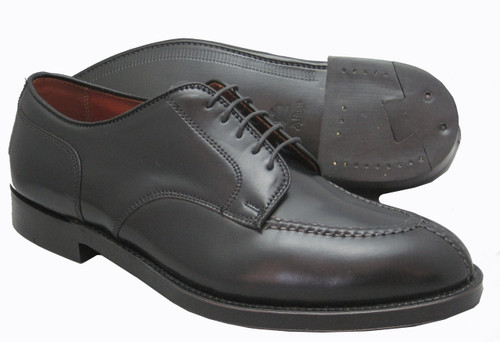This Norwegian Front Toe Blucher shoe is the premier Alden oxford shoe. It features a hand-butted seam which sets it apart, making it one of the most sought after models the Alden Shoe Company has ever designed. The process for making the upper for this style and placing it on the last is so difficult that there are only 2 or 3 highly trained hand-sewers that are tasked with this responsibility. The front of the shoe is actually a single piece of shell cordovan or calfskin, not multiple pieces that are stitched. The operator uses one tool to pinch the leather forming a "seam" and then uses 2 needles to pierce the seam on opposite sides. Quite a work of art!
- Genuine Horween Black Shell Cordovan
- Combination dovetail heels
- Goodyear welt construction
- Double oak leather outsoles
- Aberdeen last
Read below for more information about Shell Cordovan
SHELL CORDOVAN Horween genuine shell cordovan is the art of tanning at its finest. When people speak of cordovan shoes today they typically mean those made by the Alden Shoe Company in Middleboro, Massachusetts, founded in 1884. The term “cordovan” is somewhat misleading, as it historically meant the leather came from the Spanish town of Cordoba. Today cordovan means horsehide, or more specifically it’s the subcutaneous membrane within the hindquarters of the horse, which provides exactly two round pieces of leather sufficient to make one or two pairs of shoes. In the U.S. the tanning of horsehides has become the exclusive preserve of the Horween Leather Company. Horween’s tannery has produced its world-famous shell cordovan leather in Chicago since their founding in 1905. Originally the leather was marketed as strops for honing straight razors, but with the advent of the disposable safety razor demand for cordovan strops soon diminished. Horween then found a market for their shell in the footwear industry supplying a variety of shoemakers. Today Horween’s shell is widely regarded as being the world’s best, not only for its overall appearance, but also for its resistance to water spotting and its firm but forgiving temper. The tanning of cordovan is incredibly complex. Six months and more than a hundred processes are required to produce a useable hide. Horween sources horsehides from countries such as Canada or France, where horse meat is produced for food and the hides are a leftover byproduct. When the horsehides arrive at the tannery they still have a layer of hair and are covered in salt which preserves the hide and keeps it from spoiling. The hides are given an initial inspection for quality before getting trimmed down to a usable area. Next, hair is chemically removed from the hides and the horse fronts are separated from the horse butts. They then spend 24 hours in a pickling bath being turned over and over by wooden paddles, to prepare the butts to accept the penetration of the vegetable tannins that will turn the hides into leather, followed by a two-week rest. The magic truly begins when the butts are tacked onto wooden slats and lowered into pits. This pit-tanning process takes about two months, and during this time the butts are lightly agitated as they slowly absorb Horween’s signature blend of tree bark extracts. Pit-tanning for Horween’s cordovan happens in two stages. First is a thirty-day stint in the tanning pits with a mild, lightly astringent tanning solution. After that the butts are removed from the pits for trimming and a light shave to expose the shell layer, before going back into the pits for another thirty days, this time in a tanning solution with a heavier concentration of bark extracts. After leaving the tanning pits the butts rotate inside Horween’s stuffing drums where they’re impregnated with a mixture of tallows and waxes. Then the butts are hand-smeared with a layer of oil, before resting for an additional 3 months to allow all these oils and greases to fully permeate the butts. The butts are then completely shaved and trimmed down to oval-shaped membranes - the shell cordovan itself - and here the finishing begins. Dyes are applied to the shells, they get hand-slicked to even out the staining, and they’re hung to dry. Once dried each piece gets an application of Venetian Shoe Cream, and a large glazing jack with a glass rod rolls and smooths out the fibers, before a set of giant rollers completely flattens the shell for the final plating process. After a final inspection Horween’s shell cordovan is ready to be sent out into the world. Caring for Your Shell Cordovan Footwear The beauty of shell cordovan footwear is that it ages minimally and elegantly. Because of its extremely tight grain structure it does not develop the deep wrinkles and creases typically found on calfskin shoes, but instead produces more subtle “rolls”. Also, while calfskin shoes slowly dry out over time (hence the need to frequently apply conditioners and polishes), shell cordovan has ample fat infused into the leather during the tanning process which slowly releases itself onto the leather surface, so that later it merely needs to be shined up with some brushing and buffing. Polish should be applied seldomly and sparingly.
Horween’s suggestion for shell cordovan care:
1. Clean with a soft, damp cloth. Allow to dry completely away from heat and moving air.
2. Brush vigorously, for several minutes using a horsehair brush.
3. Every 10-15 wearings, apply a light haze of neutral Crème Cordovan or Venetian Cream sparingly.
4. Allow to sit at least 10 minutes, or as long as overnight.
5. Brush again, as long as you can stand it.
6. Buff with a clean soft, dry cloth






